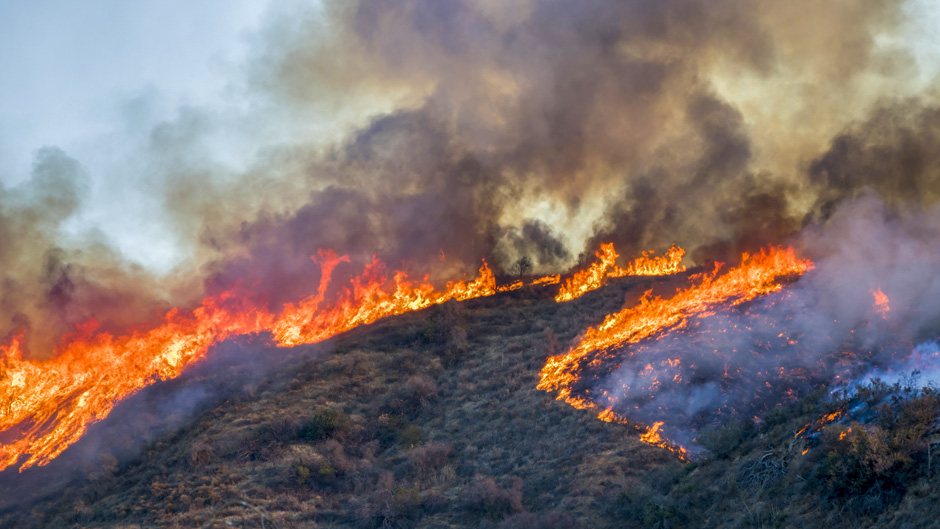Losses from the most destructive wildfire in California history, which has claimed at least 77 lives and more than 10,000 structures, are incalculable. But, years from now, the casualties are likely to mount—with cancer striking an inordinate number of the thousands of firefighters who are still battling the northern Camp Fire inferno and the Woolsey Fire to the south, both of which erupted on November 8.
Of this, Erin Kobetz, director of Sylvester Comprehensive Cancer Center’s Firefighter Cancer Initiative, is almost certain. For the past four years, Kobetz and a multidisciplinary team of researchers have partnered with firefighters across Florida to learn why their cancer rates are so much higher than the general population, and what to do about it. Among their discoveries: firefighters are inundated by chemical-related carcinogens, but not just when fighting fires. The contaminants adhere to their skin, their gear, and their clothes, and spread to their fire trucks, stations, personal cars, even their homes.
Kobetz, Sylvester’s associate director for population science and cancer disparity and professor at the University of Miami Miller School of Medicine, who has devoted much of her career addressing the high incidence of cervical cancer among Haitian women, discusses the cancer risks posed to California’s firefighters with News@TheU.
Do firefighters in California face the same cancer risks as Florida firefighters?
Cancer, not smoke inhalation, not burns, is the No. 1 in-the-line-of duty killer of firefighters nationally and internationally. It’s obviously a slower killer and, until a few years ago, not openly discussed, but exposure to chemicals that contain known carcinogens is a routine part of firefighting.
The last meta-analysis, done 16 years ago, showed an increased risk of four types of cancer in firefighters: Hodgkin and non-Hodgkin lymphomas, and prostate and testicular cancers. But other studies suggest the risk is not limited to just those cancers. We found that firefighters in South Florida have a higher risk of melanoma, and it tends to occur in younger individuals compared to the general population. The risks likely differ elsewhere too. We are about to publish new data to update and further characterize the cancer burden among Florida firefighters. Without giving too much away, we see higher incidence for multiple sites beyond those reported in the meta-analysis.
Which chemicals pose the greatest cancer risks and are they more prevalent in structural fires or brush and forest fires?
The chemicals are everywhere and include polycyclic aromatic hydrocarbons, benzene, and the fire retardant poly-brominated diphenyl ether, which are found in an array of products—from paint and furnishings to naturally burning forest fires. While trees may burn cleaner than, say, a couch, there are certain saps or phytochemicals in leaves that have carcinogenic potential.
Don’t firefighters wear gear that protects them from inhaling carcinogens?
Yes, but these carcinogens are likely absorbed through the skin, not inhaled. Absorption increases with heat and firefighters wear a lot of gear so we believe much of the exposure happens through skin absorption, not inhalation. That’s why the more than 4,000 post-fire, on-site decontamination kits that have been distributed to hundreds of fire stations and thousands of firefighters across Florida are an essential protective tool for reducing exposure.
Are the fire kits being used in California, and if not, could they be effective there?
When you’re dealing with fires like those in California, there may not be time to decontaminate. There doesn’t seem to be a fire season in California anymore. There are significant wildfires across California most of the year and they can endure for weeks. There’s a sustained exposure and that sustained exposure could increase the risk of cancer.
Firefighters also have significant disruptions to their circadian rhythms. When they are on duty and on call, they don’t sleep for an uninterrupted period of time. When they are fighting fires that never seem to end, such as in California, stress is likely a huge risk factor for disease onset and progression. In such situations, firefighters are in a constant state of fight or flight. Add that to the fact they, too, are losing their homes and their communities, and that is just challenging for health broadly.
You usually work with underserved populations like Haitian women who, for lack of a routine Pap smear, were dying of cervical cancer. Firefighters aren’t really underserved, are they?
As I got to know firefighters, I came to realize they are medically underserved in a different but meaningful way. Women in Miami's Little Haiti are the classic definition of underserved. They don’t have access to a formal health care system, and there are other structural barriers to engaging in disease prevention, such as limited proficiency in English, and lack of transportation and/or child care. Firefighters all have health insurance. They work with the health system. They have a political platform. But they are underserved in the realm of research to understand why they contribute to excess cancer risk. As different as these communities are, that’s the common thread. They are both characterized by a health disparity and there is an obligation for us to use science to use solutions to address it.
To learn more about Kobetz’s work with Haitian women and South Florida’s firefighters, view her ’Cane Talk.

